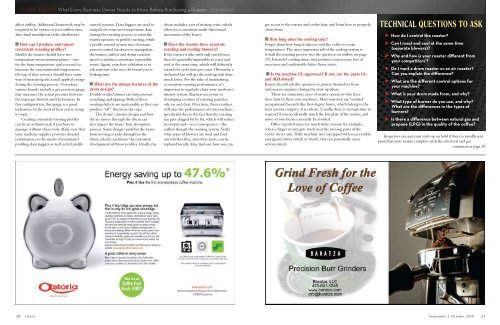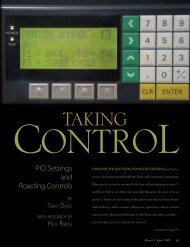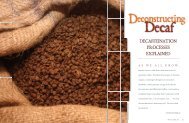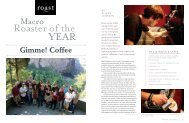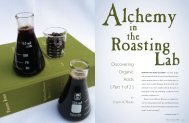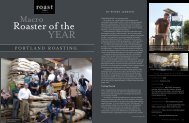In Hot Pursuit - Roast Magazine
In Hot Pursuit - Roast Magazine
In Hot Pursuit - Roast Magazine
You also want an ePaper? Increase the reach of your titles
YUMPU automatically turns print PDFs into web optimized ePapers that Google loves.
IN HOT PURSUIT: What Every Business Owner Needs to Know Before Purchasing a <strong>Roast</strong>er (continued)<br />
affect airflow. Additional homework may be<br />
required to be certain of your airflow rates<br />
after final installation of the afterburner.<br />
How can I produce and repeat<br />
consistent roasting profiles?<br />
Ideally, the roaster should have two<br />
temperature-measurement points—one<br />
for the bean temperature and a second to<br />
measure the environmental temperature.<br />
On top of that, roasters should have some<br />
way of measuring the actual applied energy<br />
during the roasting process. Nowadays,<br />
various brands include a gas pressure gauge<br />
that measures the actual pressure between<br />
the main gas throttle and the burners. <strong>In</strong><br />
this configuration, this gauge is a good<br />
indication for the level of heat you’re using<br />
to roast.<br />
Creating consistent roasting profiles<br />
can be an arduous task if you have to<br />
manage without these tools. Make sure that<br />
your machine supplier provides detailed<br />
information on the merits of automated<br />
profiling data loggers as well as full profile<br />
control systems. Data loggers are used to<br />
compile the time and temperature data<br />
during the roasting process to assist the<br />
roaster operator in profile roasting, while<br />
a profile control system uses electronic<br />
process control hardware to manipulate<br />
the burner, airflow and drum rotation<br />
speed to produce consistent, repeatable<br />
roasts. Again, your best validation is to<br />
ask someone who uses the brand you’re<br />
looking into.<br />
What are the unique features of the<br />
drum design?<br />
Double-walled drums can help prevent<br />
scorching and tipping. Both of these<br />
roasting defects are undesirable as they can<br />
produce “off ” flavors in the cups.<br />
The drum’s interior design and how<br />
the air moves through the drum can<br />
also impact the beans’ heat absorption<br />
process. Some designs prohibit the beans<br />
from moving evenly throughout the<br />
drum, which can hinder the consistent<br />
development of flavor profiles. Ideally, the<br />
drum includes a set of mixing veins, which<br />
allow for a consistent multi-directional<br />
movement of the beans.<br />
Does the roaster have separate<br />
roasting and cooling blowers?<br />
If the roaster works with only one blower,<br />
then it’s generally impossible to roast and<br />
cool at the same time, which will definitely<br />
extend the cycle time per roast. Obviously, a<br />
dedicated fan will get the cooling task done<br />
much faster. For the sake of maintaining<br />
a consistent roasting performance, it’s<br />
important to regularly clean your machine’s<br />
interior system. <strong>Roast</strong>ers are prone to<br />
developing residues of roasting particles,<br />
oils, tar and dust. Over time, these residues<br />
will alter the performance of your machine,<br />
specifically due to the fact that the roasting<br />
fan gets clogged bit by bit, which will reduce<br />
its output and—as a consequence—the<br />
airflow though the roasting system. Verify<br />
what types of blowers are used and find<br />
out whether they, and other parts, can be<br />
replaced locally. Also, find out how you can<br />
get access to the roaster and cooler fans, and learn how to properly<br />
clean them.<br />
How long does the cooling take?<br />
Forget about how long it takes to cool the coffee to room<br />
temperature. The most important job of the cooling system is<br />
to halt the roasting process (see the question on airflow on page<br />
25). Extended cooling times may produce unnecessary loss of<br />
sweetness and undesirable bitter flavor notes.<br />
Is the machine UL-approved? If not, are the parts ULand<br />
AGA-listed?<br />
Buyers should ask this question to protect themselves from<br />
unforeseen surprises during the start-up phase.<br />
There are numerous cases of roaster operators who have<br />
been hurt by their own machines. Most common are “normal”<br />
occupational hazards like first-degree burns, which belong to the<br />
least serious category of accidents. Usually, there is enough time to<br />
respond if you accidentally touch the hot plate of the roaster, and<br />
more serious burns can easily be avoided.<br />
Other reported cases are much more serious; for example,<br />
when a finger or arm gets stuck near the moving parts of the<br />
cooler stirrer arm. If the machine isn’t equipped with an accessible<br />
emergency safety switch or clutch, this can potentially cause<br />
serious injury.<br />
TECHNICAL QUESTIONS TO ASK<br />
u How do I control the roaster?<br />
u Can I roast and cool at the same time<br />
(separate blowers)?<br />
u Why and how is your roaster different from<br />
your competitors’?<br />
u Do I want a drum roaster or an air roaster?<br />
Can you explain the difference?<br />
u What are the different control options for<br />
your machine?<br />
u What is your drum made from, and why?<br />
u What type of burner do you use, and why?<br />
What are the differences in the types of<br />
burners?<br />
u Is there a difference between natural gas and<br />
propane (LPG) in the quality of the coffee?<br />
<strong>In</strong>spectors can put your start-up on hold if there is insufficient<br />
proof that your roaster complies with the electrical and gas<br />
continued on page 28<br />
26 roast September | October 2010 27


